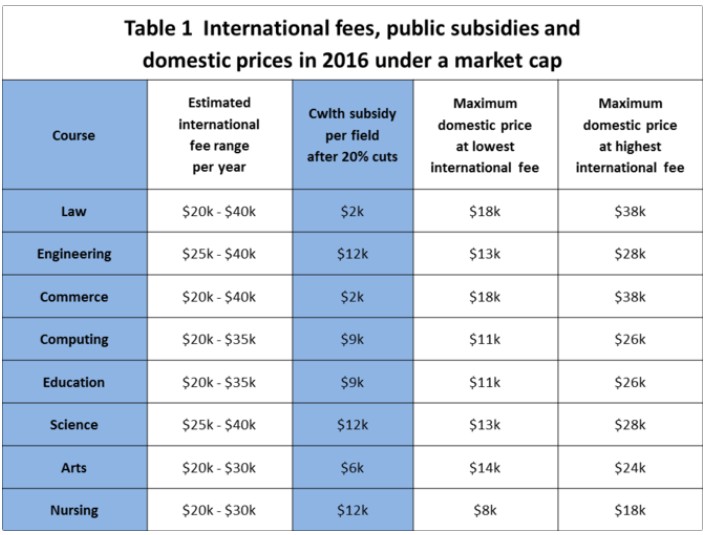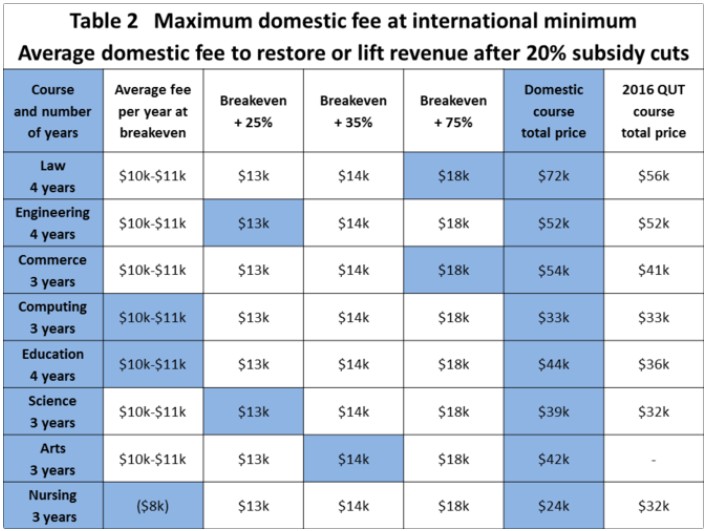Cross-posted from The Conversation:
In recent media reports, higher education policy experts Peter Noonan and Gavin Moodie dismiss the use of international student fees as an indirect “market cap” for domestic fees. Independent senator Nick Xenophon is also unconvinced:
Vice-chancellors say that international student fees are an effective cap, but if disingenuity was a subject, then vice-chancellors would get an A+ […] It would mean a spike in fees – in some courses of between 200-300%. It would make $100,000 degrees look cheap.
Implicitly, these are arguments for direct caps on fees or loans to prevent sector-wide overpricing – if federal Education Minister Christopher Pyne’s deregulation plan ever happens. As Noonan noted in a recent paper, the risk with fee deregulation is that:
… universities with the strongest market may raise prices significantly […] Other universities may price at only slightly lower levels as they will not want to be seen to be offering a cheaper and lower-quality product.
In other commentary, Moodie points to recent UK experience as evidence of the problem. Soon after partial deregulation, fees tripled. Most English universities now charge the new regulated maximum, A$16,000-17,000 per year.
Yet others see this example differently. The Group of Eight’s submission to last year’s Senate inquiry on Pyne’s initial bill argues that:
Capping tuition prices condones charging fees at the cap, which becomes the default price […] Both the Australian and UK experiences show that imposing a cap results in all providers moving to the cap.
How would a market cap work?
The direct cap debate won’t be settled except by experience. But a market cap hasn’t really been debated: the mechanics are not widely understood. The basic idea was outlined by ANU vice-chancellor Ian Young last year as:
… limiting the absolute maximum income an institution could receive for a domestic student (Commonwealth plus student contribution) to the international fee for the same course.
Tables 1 and 2 show how market caps would do this at universities charging high or low international fees. In rough figures, Table 1 shows an estimated range of 2016 prices for international students. It shows the public subsidy per field for domestic students (if planned cuts proceed). And it shows the maximum domestic fee under a high or low international cap, in these conditions.

Low price examples
Under a market cap, domestic fees at universities charging the lowest international price would, at most, be A$8,000 a year in nursing, A$11,000 in education or computing, A$13,000 in engineering or science, and so on.
Take education. In 2014, international students in Victoria in this field at Australian Catholic University, Federation University, Victoria University, Deakin University and RMIT University were charged fees in the A$18,000-21,000 range. On that basis their domestic places could be priced no higher than A$9,000-12,000 per year to comply with a market cap.
Critics of the idea have suggested that universities could simply manipulate international prices to maximise their domestic fees. But high reliance on international revenue makes it risky to play fast and loose with prices.
The risk of overpricing education in Victoria would be an enrolment drop in the domestic market, the international market, or both. Then the further risk is that entry standards fall to make up numbers, reputation erodes and the task of attracting students gets harder next time.
High price examples
Would universities charging higher international fees maximise domestic prices? This will depend in part on how much revenue they seek, beyond the price rise needed to offset the planned subsidy cuts. As I explained in an earlier Conversation article, the average break-even price for most universities is less than A$11,000 per year, and an average of A$14,000 would yield a 35% net increase in domestic fee revenue.
As Table 1 shows, a university with the highest international prices could charge, say, A$18,000 in all fields and lift net domestic fee income by 75%. In commerce its annual income per place from the fee plus the subsidy would then be A$20,000 compared with potential international income of A$40,000.
But in nursing, where the subsidy is higher and the international fee lower, domestic and international income would be the same at A$30,000. In theory, this university could charge domestic commerce students up to A$38,000. But it would then have to explain why they pay so much more than engineering students, who could be charged A$28,000 at most due to a higher subsidy.
The QUT example
In a minimum international fee scenario, Table 2 shows the maximum total course price for domestic students. This ranges from A$24,000 in nursing to A$72,000 in law. It also shows that the 2016 domestic prices published recently by Queensland University of Technology fit this picture, with most QUT fees set at or below the Table 2 maximum.
The exception here is nursing at about A$11,000 a year. With a strong market position in many fields, QUT currently charges international nursing students around A$26,000 per year.

Implications
On this view, a market cap is hardly a fig leaf for a free-for-all. It offers a reference point for institutional pricing strategies, for a price monitoring agency and for prospective students. It rules out the sector-wide price hikes seen in the UK. And A$100,000 degrees do not look cheap, as Xenophon suggests. They’d still be seen as expensive and exceptional.
Article by Geoff Sharrock, Program Director, LH Martin Institute at University of Melbourne

